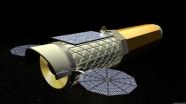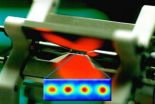(Press-News.org) Diclofenac, an anti-inflammatory agent, has been deployed successfully in human medicine for decades. In most EU countries medication containing Diclofenac is only approved for treatment of humans. In India, Pakistan and Nepal it has been deployed in veterinary medicine as well since the 90s, in particular for livestock. When vultures feed on cattle carcasses, they too ingest the drug. As a result, the populations of three species of these birds of prey – the Indian vulture, the Oriental white-backed vulture and the slender-billed vulture – have shrunk to a mere three percent of their original number.
In light of this situation, the governments of the affected countries banned the use of Diclofenac in veterinary medicine in 2006. Furthermore, centers for breeding and subsequent re-introduction of vultures into the wild have been set up and are enjoying considerable support from the British Royal Society for the Protection of Birds (RSPB). However, it will take at least ten years before the first birds can be released back into the wild.
Raising the bird offspring with Diclofenac-free food, necessitates testing meat for possible traces of the drug. This calls for analytical detection methods that can be administered in remote breeding centers by staff with little or no professional training. The scientists of the Chair for Analytical Chemistry at the Institute for Hydrochemistry and Chemical Balneology at the TU Muenchen have now developed just such a method.
The scientists started by producing a very specific Diclofenac antibody that they could use to develop a highly sensitive immunological test to detect the drug. The test uses miniaturized plastic microtiter plates and has the advantage of not requiring complex sample treatment, which translates into quick and low-cost analyses.
A pilot study in collaboration with the RSPB, the Bombay Natural History Society and the Wildlife Institute of India proved the suitability of the immune test for detecting Diclofenac in animal tissue. The procedure is currently undergoing extensive testing at an Indian vulture-breeding center. However, this method is also suitable for many other fields of application, as shown for instance in studies on Diclofenac contamination of wastewater in Bavaria and Austria. In the meantime the antibody is also being used in clinical environments to study allergic reactions to the drug.
Diclofenac binds strongly with protein molecules and the conjugate can be immobilized in the wells of the microtiter plate. When the sample and the antibody are added, the antibody can either react with the drug molecules of the sample or with the molecules previously bonded to the fixed Diclofenac-protein conjugate. The higher the Diclofenac concentration in the sample, the fewer antibodies remain to bind with the Diclofenac-bonded protein in the well. The concentration of bound antibodies can then be determined in a color reaction with a peroxidase enzyme and tetramethylbenzidine.
"With our new method we have simplified the detection of Diclofenac in animal tissue significantly," says Professor Dietmar Knopp, whose team developed the test. "This also means more tests can be carried out and that monitoring will improve." Currently, the scientists are working on further simplifying the test with the backing of the RSPB and in collaboration with the start-up company SENOVA. The goal is a single-use immunological rapid test to detect the presence of the drug that can be done in a few minutes and does not require expensive read-out equipment.
This kind of test may be needed in Europe in the near future, as well. With over 80 tons of Diclofenac sold every year in Germany alone, it is among the pharmaceutical substances most frequently found in surface water samples. "Studies have shown that Diclofenac leads to kidney damage in trout," says Professor Reinhard Niessner, head of the Institute of Hydrochemistry at the TUM. "As this substance degrades only very slowly, there may be need for action soon. As new waste water treatments are developed and implemented in the future, simple methods for monitoring their efficiency will be required."
INFORMATION:
Rapid test to save Indian vultures from extinction
Deadly side-effect of common anti-inflammatory agent
2010-09-28
ELSE PRESS RELEASES FROM THIS DATE:
Quarks 'swing' to the tones of random numbers
2010-09-28
At the Large Hadron Collider at CERN protons crash into each other at incredibly high energies in order to 'smash' the protons and to study the elementary particles of nature – including quarks. Quarks are found in each proton and are bound together by forces which cause all other known forces of nature to fade. To understand the effects of these strong forces between the quarks is one of the greatest challenges in modern particle physics. New theoretical results from the Niels Bohr Institute show that enormous quantities of random numbers can describe the way in which ...
New sound recording device helps doctors study link between cough and reflux
2010-09-28
Coughing episodes are closely related to gastroesophageal reflux symptoms in patients who experience chronic cough, irrespective of other diagnoses, according to a new study in Gastroenterology, the official journal of the American Gastroenterological Association (AGA) Institute. Gastroesophageal reflux occurs when the acid contents of the stomach back up, or reflux, into the esophagus. This typically produces heartburn, a burning sensation below the sternum where your ribs come together.
"This is the first study to investigate the temporal relationship between cough ...
Gigantic mirror for X-radiation in outer space
2010-09-28
It is to become the largest X-ray telescope ever: The International X-Ray Observatory (IXO), which has been planned in a cooperation between NASA, ESA and Japan's Aerospace Exploration Agency JAXA, will be launched into space in 2021 and provide the world with brand new information about black holes and, thus, about the origin of the universe. Its dimensions are gigantic: The surface of the mirror alone, which is to capture, for example, the cosmic X-radiation of black holes, will be 1300 m2 in size. It will consist of commercially available silicon wafers with pores of ...
A study analyzes consumer protection laws in Spain
2010-09-28
The idea behind this research arose because of the huge disparity in existing laws regulating the area of consumer protection, which made it necessary, according to the researchers, to carry out a systematic study to develop a "general report" which would gather the common principles and regulations regarding the different laws governing consumer protection. During the time this research study was underway, the Texto Refundido de la Ley General para la Defensa de los Consumidores y Usuarios (Consolidated Text of General Law of Consumer Protection) (LGDCU) was published; ...
Quantum physics: Flavors of entanglement
2010-09-28
Entanglement is a fascinating property connecting quantum systems. Albert Einstein called it the "spooky action at a distance". This bizarre coupling can link particles, even if they are located on opposite sides of the galaxy. The strength of their connections is behind the promising quantum computers, the dream machines capable of quick and efficient computations.
The team lead by Rainer Blatt at the Institute of Experimental Physics of the University of Innsbruck has been working very successfully towards the realization of a quantum computer. In their recent study, ...
Medical profession needs special training to handle self-harm, says international review
2010-09-28
Healthcare professionals are still not receiving the appropriate training and support they need to help people who self-harm and this can result in negative attitudes and inadequate levels of care.
Those are the key findings of a research review carried out by mental health specialists from the University of Nottingham, UK, and published in the October issue of the Journal of Psychiatric and Mental Health Nursing.
Staff nurse Jo McHale and lecturer Anne Felton studied 19 papers from the UK, Australia, Sweden and Ireland, dating from 1998 to 2009 and covering the views ...
Spaniards choose stable jobs over ones related to their training
2010-09-28
"If you study, you are more likely to get a stable job, even if it doesn't have anything to do with your training". This is the thinking of workers living in Spain, according to a research study by the Pompeu Fabra University (UPF), which studied the level of over-education in Spain, Italy and France, and the relationship between this and temporary work.
"This can be explained by the high levels of employment insecurity in Spain in comparison with other European countries", Luis Ortiz, author of the study and a researcher at the UPF, tells SINC.
The study, which has ...
Novel mechanism discovered for communication between proteins that cause 'cell suicide'
2010-09-28
A recent study undertaken by investigators at five research centres, amongst which is the CSIC-University of the Basque Country Biophysics Unit, provides new clues for the understanding of the 'cell suicide' process. The research was published in the latest issue of the prestigious Cell journal.
Our bodies daily eliminate in a controlled manner more than 100 million defective cells, by means of a procedure known as 'cell suicide' or apoptosis. This is a highly complicated process, any imbalances thus arising causing serious diseases, prominent amongst which is cancer. ...
Red light regulates nectar secretion
2010-09-28
Flowering plants produce nectar to attract insect pollinators. Some plant species, such as Lima bean, also secrete nectar from so-called extrafloral nectaries to attract ants which in turn fend off herbivores. Scientists of the Max Planck Institute in Jena, Germany, have discovered that the production of extrafloral nectar is light dependent. They have shown that the plants are able not only to distinguish between day and night, but also to adapt their nectar secretion to current light conditions by using a special photoreceptor, the phytochrome. Phytochrome probably influences ...
Surgery found effective for patients with aggressive prostate cancer
2010-09-28
ROCHESTER, Minn. -- In one of the first studies to focus exclusively on the outcomes after treatment for patients with high-risk prostate cancer,(http://www.mayoclinic.org/prostate-cancer/) researchers have found that surgery provides high survival rates. Collaborating researchers at Mayo Clinic and Fox Chase Cancer Center (http://www.fccc.edu/) in Philadelphia discovered that patients with the most aggressive forms of prostate cancer who had radical prostatectomy procedures had a 10-year cancer-specific survival rate of 92 percent and an overall survival rate of 77 percent.
The ...
LAST 30 PRESS RELEASES:
Tracing the quick synthesis of an industrially important catalyst
New software sheds light on cancer’s hidden genetic networks
UT Health San Antonio awarded $3 million in CPRIT grants to bolster cancer research and prevention efforts in South Texas
Third symposium spotlights global challenge of new contaminants in China’s fight against pollution
From straw to soil harmony: International team reveals how biochar supercharges carbon-smart farming
Myeloma: How AI is redrawing the map of cancer care
Manhattan E. Charurat, Ph.D., MHS invested as the Homer and Martha Gudelsky Distinguished Professor in Medicine at the University of Maryland School of Medicine
Insilico Medicine’s Pharma.AI Q4 Winter Launch Recap: Revolutionizing drug discovery with cutting-edge AI innovations, accelerating the path to pharmaceutical superintelligence
Nanoplastics have diet-dependent impacts on digestive system health
Brain neuron death occurs throughout life and increases with age, a natural human protein drug may halt neuron death in Alzheimer’s disease
SPIE and CLP announce the recipients of the 2025 Advanced Photonics Young Innovator Award
Lessons from the Caldor Fire’s Christmas Valley ‘Miracle’
Ant societies rose by trading individual protection for collective power
Research reveals how ancient viral DNA shapes early embryonic development
A molecular gatekeeper that controls protein synthesis
New ‘cloaking device’ concept to shield sensitive tech from magnetic fields
Researchers show impact of mountain building and climate change on alpine biodiversity
Study models the transition from Neanderthals to modern humans in Europe
University of Phoenix College of Doctoral Studies releases white paper on AI-driven skilling to reduce burnout and restore worker autonomy
AIs fail at the game of visual “telephone”
The levers for a sustainable food system
Potential changes in US homelessness by ending federal support for housing first programs
Vulnerability of large language models to prompt injection when providing medical advice
Researchers develop new system for high-energy-density, long-life, multi-electron transfer bromine-based flow batteries
Ending federal support for housing first programs could increase U.S. homelessness by 5% in one year, new JAMA study finds
New research uncovers molecular ‘safety switch’ shielding cancers from immune attack
Bacteria resisting viral infection can still sink carbon to ocean floor
Younger biological age may increase depression risk in older women during COVID-19
Bharat Innovates 2026 National Basecamp Showcases India’s Most Promising Deep-Tech Ventures
Here’s what determines whether your income level rises or falls
[Press-News.org] Rapid test to save Indian vultures from extinctionDeadly side-effect of common anti-inflammatory agent





